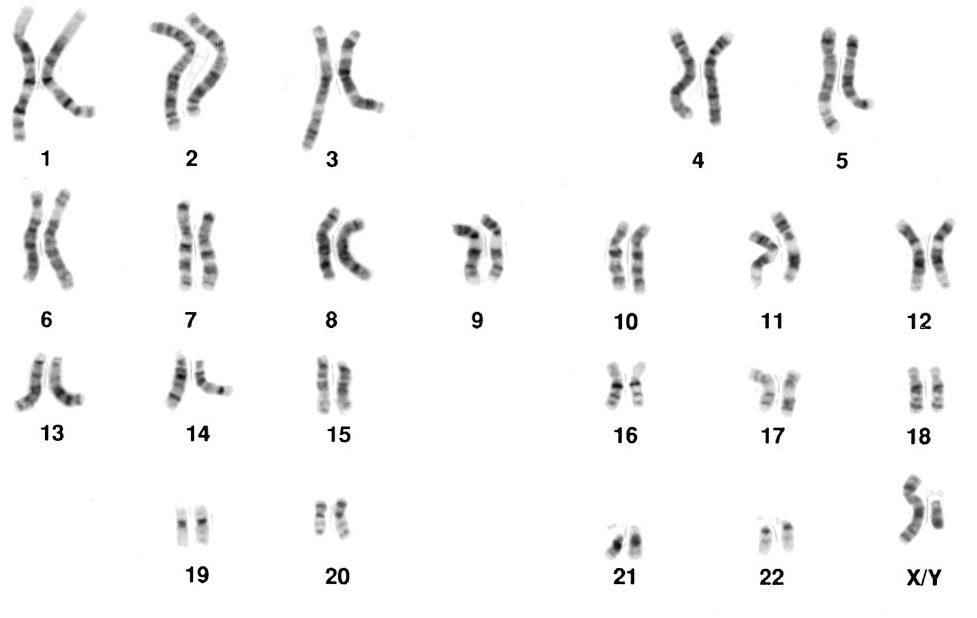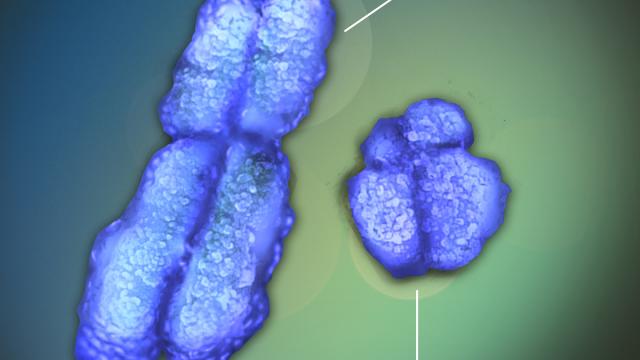The Y chromosome, a chunk of genetic code that is unique to male animals, isn’t just physically smaller than the X. It also contains far fewer genes. The X has more than 1000 genes, while the Y has fewer than 200 — and most of them don’t even work. Why do men have this odd, stunted chromosome in their genomes?
Picture: Jonathan Bailey, NHGRI
The Y is a specialist, a chunk of DNA with a very limited skill set. One of its roles is to induce maleness in a developing mammal — and that job seems to have been responsible for making the Y very weird indeed.
Once upon a time, before mammals evolved, X and Y chromosomes behaved like every other chromosome in a cell. They looked exactly the same. They carried versions of the same genes. And they could interact with each other, swapping chunks of genetic material during the early stages of meiosis, the biological process that builds sperm or eggs.
Swapping chunks of DNA lets chromosomes switch and reorder the specific genes they carry: the process is even called recombination. Recombination puts a larger variety of gene combinations inside sperm and eggs, but it is also an important way to repair mutations. Each chromosome carries different versions of the same gene, and a gene on one chromosome can serve as a template for fixing the matching gene on the other. Biologists studying sex chromosomes believe that a one-two punch of mutation and recombination inside the Y started it down an odd and solitary path.
Originally, both X and Y chromosomes held a gene called SOX3. SOX3 is part of a family of proteins called transcription factors. Transcription factors have a very particular job inside cells: they are a sort of database manager for DNA. DNA stores coded instructions for making proteins. RNAs read and translate that code into proteins. Transcription factors influence which codes are read by a cell. One of their roles is to orchestrate cell differentiation. SOX3 helps manage brain development in humans; it influences gonad formation in modern amphibians and reptiles, and probably played a similar role in the earliest mammals.
Comparing the Y chromosomes of the three branches of living mammals: placental mammals, marsupials, and monotremes, suggest that a pair of mutations around SOX3 about 180 million years ago ushered in a far more rigid system for determining sex. One mutation transformed a copy of SOX3 into a new form, called SRY, that could force a developing gonad to become a testis. The other took the chunk of chromosome containing SRY and flipped it to the opposite end of the Y chromosome. After that shift, the sequence of genes on X and Y were no longer identical, and the SOX3 on the X did not line up with the errant SRY code on the Y. There was no way to fix the code in SRY. The Y had struck out on its own.

[Image: National Cancer Institute]
Since the Y could no longer line up perfectly with the X, the two chromosomes lost their ability to recombine. The X could still correct mutations on itself by pairing with other Xs during egg production in females, but errors accumulated on the Y. Some of its genes were duplicated over and over again. Chunks of its DNA got shuffled to different parts of the chromosome. But most of all, genes dropped off the Y, until it was a fragment of its original length.
In the end, only the furthest tips of the modern Y chromosome act like a “normal” chromosome. These tiny sections share genes with the X, which may help the X and Y line up correctly during meiosis. The rest of the chromosome — 95% of it — passes unchanged from father to son, barring the occasional mutation.
Most of the Y’s male-only region does not make working proteins. Much of it babbles the same sequence of code over and over again. Other parts of the region have code arranged in palindromes: identical sequences that start from a central point and repeat as they move toward the ends of the chromosome. These stretches of DNA may let the Y fold onto itself, lining up its own sequences front-to-back to repair and maintain the few working genes it carries.
Because interspersed among all this broken, repeated code are about 16 genes that actually make proteins. A few are ancient relics, critical survival genes left over from when the Y and the X were identical. These include one protein involved with the formation of tooth enamel and another that helps build a critical part of the protein making machinery inside cells. The rest of the working genes are unique to the Y. Those genes aren’t needed for survival: half of humanity does just fine without them. But by holding the code for proteins that help grow testes and build viable sperm, evolutionarily speaking, they pack a mighty punch. [Skaletsky et al. 2003; Bhowmick et al. 2007; Wilson and Makova, 2009; Kashimada and Koopman 2010]
